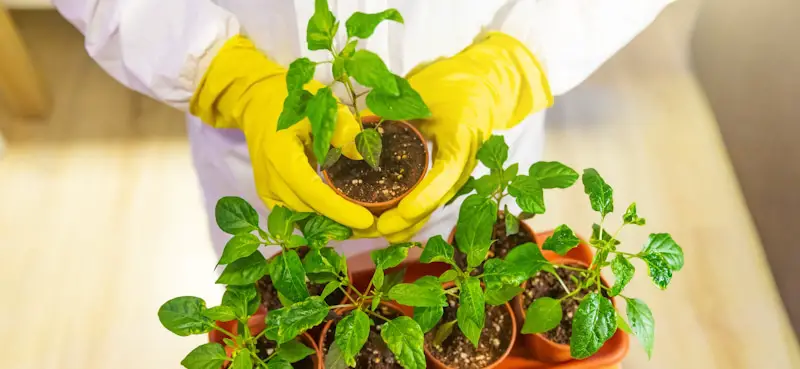Most of our dehydrated plants can become a little finicky in the height of summer. Several of our potted plants enjoy moisture but dislike “getting their feet wet,” which complicates matters because standing water can rapidly cause rot. The good thing is that you can create a humidity tray to boost humidity for the leafy gentlemen.
A pebble tray’s primary function is to create humidity for plants, usually indoor plants. Tropical houseplants predominate, yet most homes have dry, regulated air. An easy, low-tech technique to provide all the plants a richer, more humid local habitat is with a humidity tray.
To make the air surrounding your plants more humid, use humidity trays. For a humidity tray to work effectively, you do not need to buy any particular pebbles or stones. Humidity trays are a cheap solution to create the right humidity level for plants.

What Is A Humidity Tray For Plants
A humidity tray is essentially just a tray with water and many pebbles. The tray’s design is intended to raise the humidity level for indoor plants. The jar can be sitting on the rocks’ edge, not in the water, since the water would be somewhat underneath the elevation of the rocks.
Moreover, everyone knows plants might have root rot if left in a pool of water for an extended period. For indoor plants, humidity trays can only go so far in raising the humidity level. Your plants are expected to receive more moisture from the air when the liquid from the tray evaporates.
Since your plant is not resting in a water puddle, this strategy prevents root rot. Instead, it is perched a little higher than your humidity tray. The humidity level can always be checked using a hygrometer to see if the humidity tray is effective. A humidity tray will not normally help your houseplants much if your home is frequently drier than average.
It would hardly provide the air with enough moisture to make your plants happy, much less your tropical plants, which need a moderate to a higher level of humidity. Pebble trays perform much better when you really need a little more humidity but not quite enough to purchase a humidifier.
Your tropical plants will benefit from making a tray once the temperature drops. The humidity levels will alter little, but buying a humidifier might be a smart move if the temperature continues to become colder. Humidity trays can help some plants, like orchids, flourish.
These trays facilitate long-term plant growth, but perhaps not always to the extent you might anticipate. A tray is mostly used to give indoor plants a higher amount of humidity in the air. Most homes have a drier climate, which is not the best setting for tropical houseplants depending on various circumstances.
Therefore, a pebble tray is a straightforward, low-tech method of offering a quick and simple solution to raise the humidity level.
Humidity Pebble Tray For Plants
A pebble tray is a dish with pebbles and a thin water coating; pebble trays are a simple, do-it-yourself way to protect plant roots and control humidity. Pebble trays raise the relative humidity. In the pebble tray, water evaporates, increasing the humidity.
A pebble tray will work if you do not want your plant’s roots to be submerged in water or if you need to increase the humidity surrounding the plant. Pebble trays are straightforward shallow bowls or trays that can accommodate both pebbles and a little amount of water.
The plant resting on the tray is shielded from excessive water exposure at the soil line by the pebbles holding the tray together. In addition, the small amount of water in the tray gradually evaporates, slightly raising the humidity level right next to the plant. Pebbles tray function because of their straightforward form.
The liquid in the tray dissipates, rises, and raises the moisture level surrounding the plant. The pebbles or rocks prevent the plant above the top from always being wet. Pebbles are required to keep the plants in humidity trays above the water line. The actual presence of the stone deters root rot and other water-related problems.
Based on the scale of the tray and the plants it supports, different types and sizes of pebbles work well for humidity trays. Despite this, it is preferable to use glass, gravel, river rocks, and other small stones that do not absorb water. In certain circumstances, little rocks could be more effective for larger trays and plants.
Humidity Tray For Indoor Plants
A plant needs moisture for proper growth and the delivery of minerals to various sections of the plant. Pebble trays are useful in certain situations to lessen the additional strain on the plant. This quickens in hot weather.
A humidity tray for plants is a tool that assists in preserving the soil’s humidity and keeps the roots from drying up. Additionally, it keeps the soil moist. The system uses pebbles as a conduit to assist water in penetrating the soil and reaching the roots of the plants.
The stones reach the deeper soil layers and keep water from evaporating from the ground’s surface. This additional wetness allows the plant roots to absorb more liquid than they could. This facilitates the growth of plants in areas with drier climates, such as deserts, or even situations where you would need to water plants more frequently owing to a lack of rain.
By creating a humid habitat for plants, humidity trays assist in keeping them hydrated. They come in most garden supply stores and are constructed of glass or plastic. Different sized and shaped humidity trays should be positioned at the bottom of plants that must be constantly moist.
The tray should be placed on a level surface, such as a pot saucer or drip tray. To give plants moisture and humidity, you should put them close to their roots. Higher humidity is healthier for indoor plants, and numerous methods are highly recommended.
Using these recommendations, such as pebble and misting trays, has been going on for a while now. Our indoor air becomes dryer throughout the winter, which makes it more challenging for plants to thrive. In the heat, the same thing might occur with air conditioning.
Tropical indoor plants are especially susceptible. The only solution is to raise the humidity level throughout the entire house or room. The best way to achieve this is with a humidifier mounted on the furnace.
How To Make Humidity Tray For Plants
For plants that demand much humidity, a humidity tray is an excellent way to maintain moisture in the air. When you have the tray set up, it is also enjoyable, simple, and involves almost no effort from you. You need three materials to create your humidity tray: a shallow tray large enough for the plant to fit inside, water, and rocks or pebbles.
Put your stones in the tray and distribute them equally as you can. When you pour water in, it will settle a little bit, so it does not need to be precise. Pour water in gradually until it reaches the tops of the rocks. A layer above the water should be present for such a plant to sit on.
Your planter should never be submerged in water. The pebbles’ purpose is to support it. Then finish by placing your plant atop the pebbles. Place the tray in its new location and observe how well your plant does in the humidity.
Final Thoughts
Humidity trays are a terrific technique to effectively control the humidity and moisture levels in your plant’s environment. They are useful for shielding your plants’ roots and soil from unwanted exposure to too much water. Wherever you use it, they can add a calming, quiet ambiance depending on your chosen materials.
Victoria is the owner and main author of hobby plants. She loves spending her free time in her garden planting and taking care of her plants. Victoria hopes you enjoy the content here!

![Polka Dot Plant Care? [Everything You Need To Know] Polka Dot Plant Care? [Everything You Need To Know]](https://www.hobbyplants.com/wp-content/uploads/2022/08/polka-dot-plant-care-300x158.jpg)


![Why Is My Fiddle Leaf Fig Dropping Leaves? [ANSWERED] Why Is My Fiddle Leaf Fig Dropping Leaves? [ANSWERED]](https://www.hobbyplants.com/wp-content/uploads/2022/06/why-is-my-fiddle-leaf-fig-dropping-leaves-300x158.jpg)
![Why Are My Bird of Paradise Leaves Curling? [FIND OUT HERE] Why Are My Bird of Paradise Leaves Curling? [FIND OUT HERE]](https://www.hobbyplants.com/wp-content/uploads/2022/07/bird-of-paradise-leaves-curling-300x158.jpg)
![Why Are My Orchid Leaves Turning Yellow? [Find Out Here] Why Are My Orchid Leaves Turning Yellow? [Find Out Here]](https://www.hobbyplants.com/wp-content/uploads/2022/07/orchid-leaves-turning-yellow-300x158.jpg)
![Why Is My Bamboo Plant Turning Yellow? [Find Out Here] Why Is My Bamboo Plant Turning Yellow? [Find Out Here]](https://www.hobbyplants.com/wp-content/uploads/2022/07/why-is-my-bamboo-turning-yellow-300x158.jpg)
![Why Are My Peace Lily Leaves Turning Brown? [EXPLAINED] Why Are My Peace Lily Leaves Turning Brown? [EXPLAINED]](https://www.hobbyplants.com/wp-content/uploads/2022/07/peace-lily-leaves-turning-brown-1-300x158.jpg)

![Why Does My Majesty Palm Have Brown Tips? [EXPLAINED] Why Does My Majesty Palm Have Brown Tips? [EXPLAINED]](https://www.hobbyplants.com/wp-content/uploads/2022/08/majesty-palm-brown-tips-300x158.jpg)
![Why Is My Aloe Plant Turning Brown? [FIND OUT HERE] Why Is My Aloe Plant Turning Brown? [FIND OUT HERE]](https://www.hobbyplants.com/wp-content/uploads/2022/07/why-is-my-aloe-plant-turning-brown-300x158.jpg)
![How Do You Propagate a Money Tree? [COMPLETE GUIDE] How Do You Propagate a Money Tree? [COMPLETE GUIDE]](https://www.hobbyplants.com/wp-content/uploads/2022/06/how-to-propagate-money-tree-300x158.jpg)